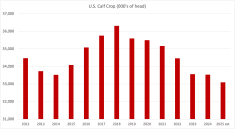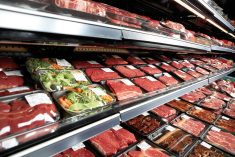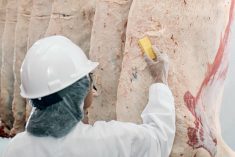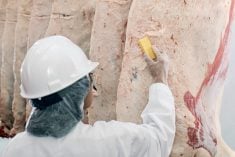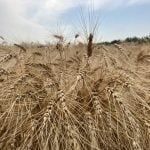Drought continues to afflict the U.S. cattle/beef industry. Since I last wrote about its consequences in my May column, conditions have only gotten worse in many parts of the country and there is no relief in sight. These conditions continue to force cattle into feedlots and cow-calf producers to keep reducing their beef cow numbers due to lack of grass and extremely high input costs. Hay prices, for example, are historically high.
In the U.S., the number of cattle in feedlots 1,000 head or larger remains historically large for yet another month mainly because of the drought conditions. The August 1 cattle-on-feed total of 11.22 million head was up 1.4 per cent from August last year. It was 150,000 head above a year ago and was the second-highest August 1 inventory since the data series began in 1996. But it was 60,000 head below the August 1 record noted in 2020.
July placements totalled 1.77 million head, which was 1.8 per cent above a year earlier and three per cent above analysts’ average forecast. July marketings totalled 1.83 million head, which was down 3.7 per cent from last year. Marketings were plagued with one less marketing day, noted Andrew Gottschalk of HedgersEdge.com. The marketing rate (marketings versus the COF total) was 16.1 per cent, a record low for July. First-half marketings, despite generally positive weekly harvest levels, are only 30,000 head above year-ago levels. The bulk of the increase in harvest levels this year is due to beef cow liquidation, he said.
Read Also

The Canadian Cattle Association’s international advocacy efforts
Global ag policies affect Canadian food policy, so the Canadian Cattle Association participates in international and domestic forums
[RELATED] Good buyer demand pushes feeder cattle prices higher
The enforced movement of cattle into feedlots means the number of market-ready cattle will remain ample the rest of this year. Front-end fed cattle supplies relative to last year will peak this month for the balance of this year, said Gottschalk. This long-awaited event was delayed as drought continually forced cattle into feedyards. This in turn was the cause of the extension of the period of record front-end supplies. But this supply is projected to decline from September into the beginning of the new year by approximately 453,000 head. The five-year average seasonal decline for the same time frame is 294,000 head. The drop in front-end supplies in 2022 would then total 159,000 head more than the norm, he said.
USDA’s Economic Research Service (ERS) also noted the impact of drought in its August Livestock, Dairy and Poultry Outlook report. What it called robust cattle slaughter levels caused ERS to raise its cattle price forecasts for late 2022 and 2023. There are a couple of takeaways regarding cattle slaughter in the first half of 2022, said ERS. The first was the aggressive culling of beef cows. This was likely based on producers’ reaction to pasture conditions and increased operating costs, and then by packers’ ability to achieve weekday slaughter levels of fed cattle, the highest observed since 2013. Strong domestic wholesale beef cutout and lean trimming prices, supported by strong domestic beef demand and record export sales, helped support this level of slaughter, said ERS.
At the beginning of the second half of 2022, drought conditions intensified through July into August, particularly in the southern and central Plains and the Southeast, said ERS. As a result, pastureland conditions have declined and are at levels typically occurring in the fall. This continues to manifest itself in beef cow slaughter as 60 per cent of all cattle are experiencing drought and producers continue to cull deep into their herds. As a result, the pace of beef cow slaughter in July was the fastest recorded since USDA began reporting the series in 1986, said ERS. Right now, as one would expect, the U.S. industry is praying for rain.



